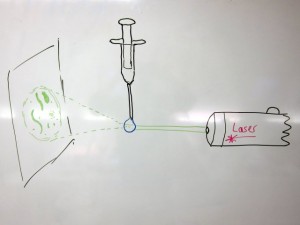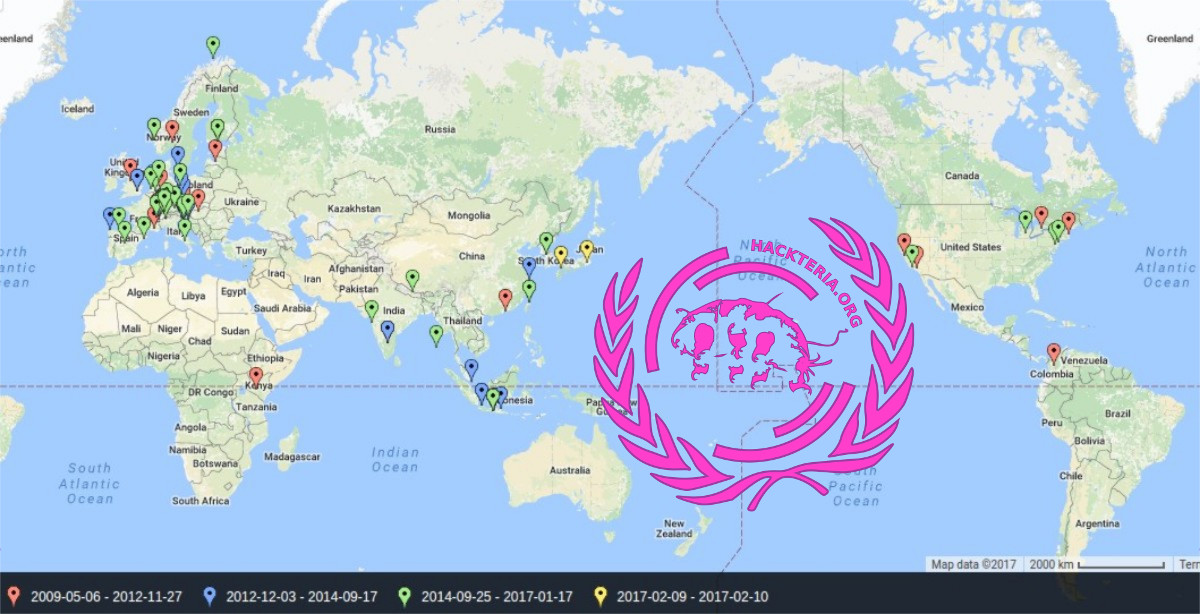Overview
Here i want to describe a hack how to modify a (quite strong) green laser pointer with an old lens from a webcam into a microscope projector, which magnifies tiny living microorganisms from a natural pond or a piece of fresh moss onto your wall. Nowadays strong green laser pointers can be bought everywhere, eg. at the chinese store around the corner or ordered on ebay. The stronger the better, try to go for one above 30mW, the example below uses a 100mW, which even allows the projection at daylight. Also look around for an old or cheap webcam with a big lens that can easily be screwed out.
On my viddler channel you can find my first experiments in a hotelroom in Hongkong…
How to
Now take out the lens from the webcam, flip it upside down and place it on the laser pointer, try it. You should see a large bright circular projection at your wall. If you move around the lens a bit you see how to align the lens and the laser properly. You might also see shadows of dust particles on the lens and the laser coverglass, make sure to clean everything properly. Now just tape the lens in the correctly aligned position.
To be able to project living organisms on your ceiling, it’s best to somehow fix the laser-micro-projector in an upright (vertical) position. You can build something out of cardboard or plywood, or just tape the laser onto the edge of your table. Because most lasers come with a button to turn it on, try to tape down the button aswell, so its always on, but be aware that its using a lot of batteries. You might also try to run the laser with a power supply, 3.3 to 4 V is usually ok, more might damage the laser forever. And check the polarity of your power, most of the time the outer metal cover is plus (+) and the little spring inside is ground (-).
 Now hold something into the beam of light and you see its shadow cast onto your wall. You will also see, that the closer you get to the lens, the bigger the projected shadow will be and at some point the image gets weird and finally flips upside-down. This is when you go through the focus point of the laser, simple optics, lesson 1. In the video below I added a small mirror on top to project the image back down onto the table, after i got a stiff neck staring at the ceiling for hours…
Now hold something into the beam of light and you see its shadow cast onto your wall. You will also see, that the closer you get to the lens, the bigger the projected shadow will be and at some point the image gets weird and finally flips upside-down. This is when you go through the focus point of the laser, simple optics, lesson 1. In the video below I added a small mirror on top to project the image back down onto the table, after i got a stiff neck staring at the ceiling for hours…
To be able to look at living microorganisms you should build a stable structure, which is around 2-4 mm above the lens, where you could place a glass slide, a petri-dish or some other transparent, flat thing that can hold a drop of water. So now get some fresh sample from a pond in your neighbourhood, some water from a potted plant or vase in your house or go climb your roof to collect some fresh juicy moss that has been growing there for years, you might even find some waterbears… you can see an old experiment I did with waterbears and lasers on my vimeo channel.
It’s alive, but how big is it?
Depending on your source of sample it might be full of live. Wait a little bit until the shaking and vibrating has stopped (because this is also magnified!) and you should see little speckles of shadows moving around lively. Maybe you will also find larger animals, such as little worms or insect larvae swimming around, spanning over the whole projection. But what is this stuff and how big is it?
 As you have seen earlier, the magnification depends on the vertical position of the sample. To start with, its easier to put it further out, so you get a good overview of whats going on. There is a lot of so called protozoa in a little droplet of fresh pond water (the earliest microscopist A. Leeuwenhoek have termed them animalcules), little worms (nematodes), flagelates, rotifers, parameciums and many more… some of them are multicellular organisms, some of them just one single cell. You will also see a lot of non-moving things, this might be pieces of stones, or plants, single cellular algae or fungi etc. With a setup like this its easy to see small protozoa (thats the ones moving around) with a size of starting from 20 µm up to 1 mm. The worms you see in the video below have a length between 100 µm and 500 µm.
As you have seen earlier, the magnification depends on the vertical position of the sample. To start with, its easier to put it further out, so you get a good overview of whats going on. There is a lot of so called protozoa in a little droplet of fresh pond water (the earliest microscopist A. Leeuwenhoek have termed them animalcules), little worms (nematodes), flagelates, rotifers, parameciums and many more… some of them are multicellular organisms, some of them just one single cell. You will also see a lot of non-moving things, this might be pieces of stones, or plants, single cellular algae or fungi etc. With a setup like this its easy to see small protozoa (thats the ones moving around) with a size of starting from 20 µm up to 1 mm. The worms you see in the video below have a length between 100 µm and 500 µm.
 We have to make a difference between these animals and plants (Eukaryotes) and bacteria (Prokariotes), the latter is a completely different kingdom of life and also bacteria are much smaller, starting from a bit less than 1 µm to 5 µm. And with a laser light of the wavelength of 512 nm (Yes that’s a green laser!), as a rule of thumb, even with the best microscope you wont be able to detect anything that’s smaller than this wavelength you are looking at it with. So considering the quality of the laser and most importantly the quality of our lens we are using, we sadly wont be able to see individual bacteria, but definitely some larger eukaryotic cells.
We have to make a difference between these animals and plants (Eukaryotes) and bacteria (Prokariotes), the latter is a completely different kingdom of life and also bacteria are much smaller, starting from a bit less than 1 µm to 5 µm. And with a laser light of the wavelength of 512 nm (Yes that’s a green laser!), as a rule of thumb, even with the best microscope you wont be able to detect anything that’s smaller than this wavelength you are looking at it with. So considering the quality of the laser and most importantly the quality of our lens we are using, we sadly wont be able to see individual bacteria, but definitely some larger eukaryotic cells.
Material needed
* Green laser pointer (<30mW)
* Lens from webcam
* some glue and cardboard
* fresh water from a pond or a piece of moss
Example video with nematodes
Ultra simple lensless laser microscope

And this one is even much simpler… just hold a small droplet of your sample into the laserbeam! The round shape of the droplet itself serves as a lens and thus magnifies the projected beam. The smaller the droplet, the bigger the magnification. But of course the diameter of the laserbeam is usally around 1 – 2 mm, so you loose light if the droplet is even smaller than that. Try to use a syringe that can make really small droplets. Because of the hanging droplet, there is usually a lot of turbulence inside, so you’ll see many little speckles swirling around for a while. Iin the movie below I am looking at nematodes (anguila aceti), which are 200 µm to 1 mm in lenght.
A similar project by teravolt has been recently been featured on the Make Projects. Check it out, but be aware of some wrong ideas about the size of bacteria ect..


















This is absolutely fantastic. I would love to put together a dance party that uses biological visuals.
[…] has another take on building a laser projection microscope. Last year we saw a laser-based microscope that shined the beam of light through a water droplet […]
[…] post from dusjagr over on Hacketeria, who reports success using a 100 mW green laser with the lens from a cheap webcam, in the […]
WARNING – danger of permanent eye damage/loss!
Especially since 100mW sound weak to many people:
such a laser still is strong enough to burn holes into your retina´, regardless whether a brief (accidental) look directly into the beam or a short reflected on glass, water droplets, glossy surfaces, etc.
Also a very good way to burn out your retina’s or those of your friends. If you insist on being an idiot, then do so alone.
Amazing. Imagine the poor schools biology class potential..
Not to mention easy first-look check if water found in oasis is good to drink.
Why this stuff is not in survival kits?
some thoughts about security… after the laser beam goes through the lens its split up, thus the intensity per area is massively reduced. i wouldnt worry to much 🙂
Publication by Gorazd Planinsic, University of Ljubljana:
http://www.fmf.uni-lj.si/~planinsic/physteac/physteac_gp.pdf
[…] un comentario No necesita mayor explicación. Es un microscopio a base de un laser, ¿Como lo hace? hay que dirigir el haz de luz del laser directamente a una gota de cualquier […]
I first saw this on a youtube video and I’m using it in my high schools science fair. It’s so cool! I managed to see some water fleas with just a laser and a syringe full of pond water.
[…] But is there more other life down there? To check this we went for a µ-Cave Safari, equipped with laser-projectors, MobileLabs, Plankton-Nets and other fun stuff to carry around in the muddy […]
What’s the science of this microscope? Is it just simple optics? I want to measure if the wavelenght of the laser or the material is important.
i think there is a link to some other sources explaining the physics, there is a phys edu paper explaing all the details, let me find it and send you by email… and yet it’s optics, which is not always simple. and yes the wavelength matters… check raleigh limit on wikipedia.
Very good idea. I must try it.